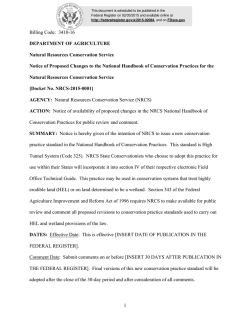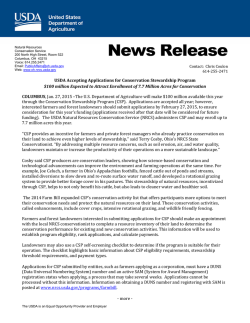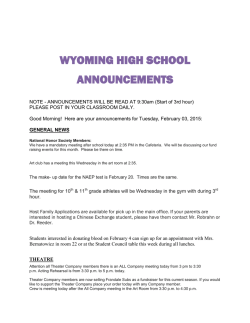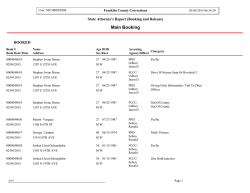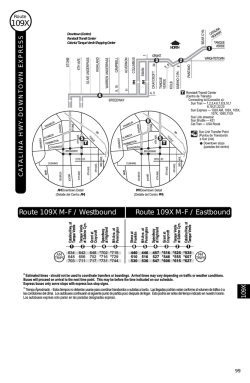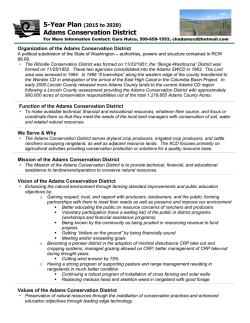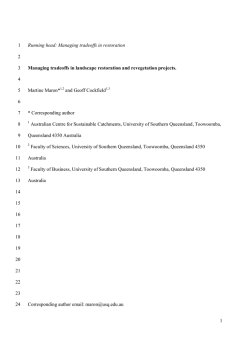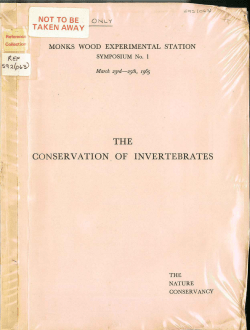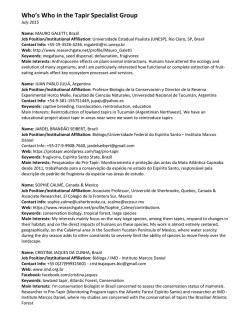
January/February - Converse County Conservation District
SOLAR CONVERSION COST-SHARE PROGRAM Volume 18, Issue 1 January/February 2015 Converse County Conservation District is pleased to announce a new cost-share program. This program will provide 50% cost share up to $5,000 for power conversion of a functional well to a solar pumping system. CCCD EXPRESS CONVERSE COUNTY CONSERVATION DISTRICT Solar Conversion Program Criteria Existing well MUST be permitted with Wyoming State Engineers Office (SEO). If not currently permitted, producer must obtain a SEO permit for existing well before applying for the program. Existing well casing must be of good quality and not corrupted by age, collapsed, rotted by corrosion or constructed of substandard materials. Work with a Wyoming licensed pump installer to be sure you are meeting these requirements. Wells with poor casing should be decommissioned and sealed according to SEO guidelines. Pump test of existing well will be required to insure well is capable of producing required amount of water needed for number of livestock. The test will also indicate the amount of drawdown in the well and future pump location. Pump size will be such that well does not exceed original permitted water use. If additional water is needed, an application to the SEO office will be made to change use and amount. The existing well head must be protected to insure that possible sources of polluted runoff cannot contaminate the well’s aquifer. Quality of the water must be compatible with the planned use. The water should be tested to insure water quality parameters are sufficient for intended use. One project application per funding cycle will be accepted. Applications for this funding cycle are available now and will be accepted until March 13, 2015. Call or stop by Converse County Conservation District and get yours today! WWW.CONSERVECONVERSE.ORG 2014 ANOTHER WACKY WEATHER YEAR 2014 finished out in weird weather fashion. The month of November was one of the most extreme months in Wyoming weather history. At the Natrona Airport Casper tied an all time record high on Nov 1st, and then set an all time record low on the 12th during the mid Nov cold weather outbreak. The following are some precipitation summaries for 2014: Douglas (foothills) 15.15” 108% ave Riverton 8.1” Casper 12.13” Rock Springs 4.24” 50% ave *2nd driest on record 97% ave Lander 11.72” 93% ave 95% ave Worland 8.26” 109% ave CURRENT SNOW PACK DATA SNOTEL SNOW DEPTHS Upper North Platte 90% ave Windy Peak 14” Lower North Platte 86% ave Laprele Creek 19” Sweetwater 85% ave Reno Hill 23” Laramie River 100% Casper Mtn 32” Powder River 116% Brooklyn Lake 41” Togowtee Pass 50” Grand Targhee 82” Canyon (Yellowstone) 34 Upcoming deadlines for Farm Service Agency: Agriculture Risk Coverage Program (ARC) and Price Loss Coverage Program (PLC): February 27th - Base Acre Reallocation March 31st - Program Election Summer 2015 - Enrollment Appointment cards have been mailed to producers who have base acres. We look forward to meeting with you to discuss the new Farm Bill programs. Attention Wool Producers! If you wish to participate in the 2015 LDP Program, you will need to sign form CCC-633 EZ page 1 and return it to our office before losing beneficial interest in your wool. The deadline for returning the form to our office is January 31, 2015. UNITED STATES DEPARTMENT of AGRICULTURE’S EQUAL EMPLOYMENT OPPORTUNITY POLICY The U.S. Department of Agriculture (USDA) prohibits discrimination in all its programs and activities on the basis of race, color, national origin, sex, religion, age, disability, political beliefs, sexual orientation, or marital or family status. (Not all prohibited bases apply to all programs). Persons with disabilities who require alternative means for communication of program information (Braille, large print, audiotape, etc.) should contact USDA’s TARGET Center at (202) 720-2600 (voice and TDD). To file a complaint of discrimination, write USDA, Director, Office of Civil Rights, Room 326-W, Whitten Building, 1400 Independence Avenue, SW, Washington, D.C. 20250-9410, or call (202) 720-5964 (voice or TDD). USDA is an equal opportunity provider and employer. Page 2 C C C D E X P R ES S “WORKING FOR THE WYOMING WAY OF LIFE” Board Supervisors Don Wagoner and Stan Mitchem and District Manager Michelle Huntington attended the Wyoming Association of Conservation Districts (WACD) Annual Convention on November 18-20, 2014 in Sheridan, WY. This years’ theme was “Working for the Wyoming Way of Life” and many workshops and trainings were offered. Attendees heard from Brent Van Dyke, 2nd Vice President of the National Association of Conservation Districts and our Wyoming Congressional Delegation. Keynote speaker, Dan Dagget, spoke on moving from EcoRadical to Conservative Environmentalist. During the Awards Luncheon, Michelle Huntington received the 2014 WACD Outstanding Employee award. “In everything she does, Michelle Huntington gives 100 percent, and she is a valuable asset to the conservation district family,” said Converse County Conservation District in nominating Michelle for the Outstanding Employee award. Michelle is always willing to lend a helping hand with any project. Michelle has been a valuable component in a wide variety of projects in Converse County and around the state. Michelle receives her award from WACD President Shawn Sims and Chris Wichmann of the Wyoming Department of Agriculture. Photo courtesy of Leather ‘N Lace Photography. Tree orders are being accepted now! Several species have already sold out—you are encouraged to check species availability before placing your order. Updated order forms can be obtained by stopping in at the office or calling CCCD at 358-3050 ext. 109. NOTE: The CCCD office will be closed Monday, January 19th in observance of MLK, Jr. Day and on Monday, February 16th in observance of President’s Day. There are a lot of concerned tree owners this winter in regards to the die off observed on Austrian Pines. The following information was provided by Ashley Garrelts, UW Extension Office in Douglas. If the tree is turning brown near the tips of the branches (or the entire branch) that loss is actually probably due to what we call winter burn. Winter burn is caused by dry soils and/or sudden temperature changes. The newest growth often remains succulent through summer and fall, when it becomes prone to damage by sudden cold like we experienced on November 11-13. On Monday, November 10 the daytime temperatures were in the 60s. The very next day on November 11, the daytime temperatures were in the single digits. Lows during this time reached -25 to-30, which is the lowest temperature Austrian pines can withstand as indicated by their horticulture hardiness zone designation. Pine needles survive winter by developing the ability to tolerate extracellular ice formation. Ice formation inside the cell, however is fatal. This temperature varies with species, population, among individuals, and even between different tissues. Trees acclimate by gradually increasing their cold tolerance. Cells increase fat concentration, break apart protein chains, and water migrates out of the cell. Water outside the cell walls freezes first and as this water changes from a liquid to a solid, small amounts of heat are released. This energy helps prevent the water inside the cell from freezing. When trees do not have time to acclimate due to sudden changes in temperature, ice formation can occur in the cell and thus fatally damage the needles on that tree. This is what I believe has happened to many of our Austrian pines in the area. Another thing to consider however is dry soils. Evergreens continue to transpire water through needles during the winter. If they cannot take up enough to replace what is lost, needle burn may result. If you have a drip system, one emitter per tree may have been sufficient when the trees were planted, but root growth since then may have extended the roots beyond the reach of the emitter. Also providing supplemental water during the winter when the drip system is not in use is important, especially during dry periods when there is no snow and the dry Wyoming winds are howling. Consider also expanding the mulch around your trees. Adding mulch so that is six feet across and 2 inches deep. Do not allow the mulch to pile up against the trunk. Sadly to say the brown needles will not re-green. To see if your tree will survive, check the white buds at the end of the branches. Break off one of them from a low, less visible branch. If it seems moist, is green inside, and smells “piney” that is a good sign. These buds are the promise of the new growth next May. If you lose your pines and you would like to replace them next spring, conifer trees that are recommended for this area due to their drought tolerance and cold hardiness include: Scots Pine, Ponderosa Pine, Rocky Mountain Juniper, Eastern Red Cedar, White Fir (sometimes known as Colorado fir), or White Spruce. If trees are losing needles on the inside of the tree, that is what is called fall/winter needle drop and is perfectly normal. VOLUME 18, ISSUE 1 Page 3 Helping you protect soil, water, air, wildlife and our way of life Presorted Standard US Postage Paid Douglas, WY Converse County Conservation District Permit No. 13 911 S. Windriver Drive Douglas, WY 82633 Phone: 307-358-3050 x 4 [email protected] HOURS: 7 a.m.—4 p.m. Board of Supervisors Stan Mitchem, Chairman Johnie Pickinpaugh, Vice Chairman Don Wagoner, Secretary/Treasurer Shelly Falkenburg, Member David Claus, Member District Staff Michelle Huntington, District Manager NRCS Staff Tim Schroeder, District Conservationist ATTEND A CCCD BOARD MEETING The Converse County Conservation District holds Board Meetings the third Thursday of each month starting at 4:30 p.m. We welcome your input, ideas, questions, and concerns regarding our projects and programs! Meetings are open to the public pursuant to Wyoming Statute 16-4-403. YOUR District—YOUR Priorities In the 1930’s, when dust clouds from the Great Plains darkened the skies over the eastern United States our countries natural resources were in peril. As a result of the Dust Bowl, the Soil Conservation Act of 1935 was established to develop and implement soil erosion control programs across the nation. The creation of the Soil Conservation Service (now known as Natural Resources Conservation Service) soon followed. In 1941, according to Wyoming State Law, policy was declared to provide for the conservation of soil and water and to preserve all natural resources within the State. Conservation Districts were formed to serve as the grass-roots link between the local community and the federal government. The locally elected Board of Supervisors are the only local government charged specifically with the responsibility of representing local people on natural resource issues and have been doing so in Converse County since 1947. Every five years, the District is charged with the task of developing a Long Range Plan to provide direction to the District. Although the District is guided by the legislative declarations and policy of the Wyoming State Legislature as stated in W.S.S. 11-16-103, it is always an objective of ours to meet the needs of residents and focus on natural resource management specifically in Converse County. As Converse County Conservation District is locally funded by a mill levy, we are YOUR District. Your input is invited and encouraged as we begin the Long Range Plan process and build the foundation that our future programs and projects will be based on. Watch your mail the next few weeks for an informational brochure and a survey. Converse County Conservation District is YOUR District and we want to be addressing YOUR priorities as we move forward. Together we can accomplish great things!
© Copyright 2026

